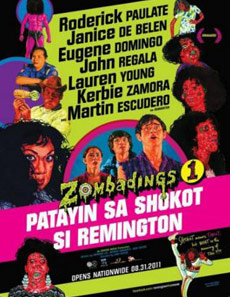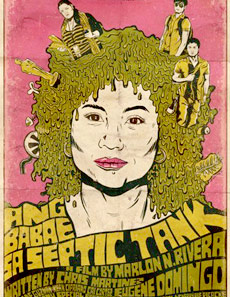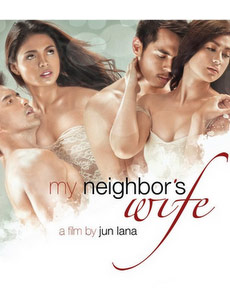Filtered By: Lifestyle
Lifestyle
Gay zombies, the return of Nora, and other pop phenomena in 2011
By KATRINA STUART SANTIAGO
The year in TV, movies, and media: My top 11 pop culture highlights This list comes with a disclaimer: I can only watch so much local TV at any given time, and with another channel fighting it out with the two bigger networks, it does become difficult to even channel surf and not miss a show or two. Now while TV’s free, movies aren’t, and it has to be said that I’ve spent on really bad local movies in the past year. The ones that have made it on this list are not necessarily the better ones, as they are the ones that I feel affected a shift in cinema in the past year.
The decision to include media as a category in itself is borne of how in the past year TV began to consciously use social networking sites as a way of disseminating information on the one hand, but also as a way of sensing the online public pulse on the other. Of course there’s reason to celebrate the freedoms that social media allows, where we all might have opinions. But that comes with responsibility that we have yet to clearly have a sense of, and right there is how it becomes unstable and unwieldy, if not always a form of bullying waiting to happen.  Social networking and media become us. It seems it was the year of social networking and media, if only because 2011 had us constantly connected to Facebook and Twitter, what with mobile networking becoming more and more accessible. This year we were forced to reckon with the responsibility that this constant connectedness requires, which is to say that it became clear how we might be unprepared for it really, with Twitter trending topics no matter how inane or petty making the mainstream news, with retweets and Facebook shares making bullies out of us. Without a doubt, we use the same networking skills to organize ourselves into a relevant whole in the aftermath of a storm or some other tragedy. Now the challenge has to be about teaching ourselves to be more responsible with what we share, what we tweet, and knowing full well that there are many ways to keep our accounts secure if our goal is to overshare the overly personal.
Social networking and media become us. It seems it was the year of social networking and media, if only because 2011 had us constantly connected to Facebook and Twitter, what with mobile networking becoming more and more accessible. This year we were forced to reckon with the responsibility that this constant connectedness requires, which is to say that it became clear how we might be unprepared for it really, with Twitter trending topics no matter how inane or petty making the mainstream news, with retweets and Facebook shares making bullies out of us. Without a doubt, we use the same networking skills to organize ourselves into a relevant whole in the aftermath of a storm or some other tragedy. Now the challenge has to be about teaching ourselves to be more responsible with what we share, what we tweet, and knowing full well that there are many ways to keep our accounts secure if our goal is to overshare the overly personal.
 A coming of age like no other. Written by Michiko Yamamoto, Raymond Lee, and co-written and directed by Jade Castro, Zombadings was an absolutely heartwarming story of coming into gayness. That is, a coming of age for a whole fictional community that begins homophobic and filled with zombies, and comes to accept homosexuality as a valid choice to make, no matter how late in the day, or in this case, how late in a father’s life and how early in a young teenage boy’s. Granted the use of zombies vis a vis kabaklaan has its pitfalls, but I do think that this movie navigated the discourse of the latter well, logically rendering even the most macho (hello, John Regala as the father), as possible ally against homophobia. We got to give that its power.
A coming of age like no other. Written by Michiko Yamamoto, Raymond Lee, and co-written and directed by Jade Castro, Zombadings was an absolutely heartwarming story of coming into gayness. That is, a coming of age for a whole fictional community that begins homophobic and filled with zombies, and comes to accept homosexuality as a valid choice to make, no matter how late in the day, or in this case, how late in a father’s life and how early in a young teenage boy’s. Granted the use of zombies vis a vis kabaklaan has its pitfalls, but I do think that this movie navigated the discourse of the latter well, logically rendering even the most macho (hello, John Regala as the father), as possible ally against homophobia. We got to give that its power.  The TV5 Shift. It’s difficult not to be taken aback by TV5’s Christmas station ID if only because it features actors and actresses that used to inhabit the bigger networks. Dolphy and Aga Muhlach, Lorna Tolentino and Nora Aunor and Sharon Cuneta, alongside Vic Sotto and Joey de Leon, are difficult names to beat really. That they’re on the roster of TV5 is a reminder of how all it takes to be a new player in the TV game is to channel enough money to make those big names move. Now the goal has to be spending a similar amount for the creative teams that will make that shift worth it. And will actually make me want to stay on TV5.
The TV5 Shift. It’s difficult not to be taken aback by TV5’s Christmas station ID if only because it features actors and actresses that used to inhabit the bigger networks. Dolphy and Aga Muhlach, Lorna Tolentino and Nora Aunor and Sharon Cuneta, alongside Vic Sotto and Joey de Leon, are difficult names to beat really. That they’re on the roster of TV5 is a reminder of how all it takes to be a new player in the TV game is to channel enough money to make those big names move. Now the goal has to be spending a similar amount for the creative teams that will make that shift worth it. And will actually make me want to stay on TV5.  Jose, Wally, Paolo. You might not know their names really, but if you watch Eat Bulaga regularly enough, the kind of work these three guys put into the “Juan For All, All For Juan” segment is astounding. Jose Manalo, Wally Bayola, and Paolo Ballesteros sweat it out in the smallest and most remote of barangays, deal with crowds in impoverished areas with nary a discriminatory bone, and can just make you laugh with humor that doesn’t look down on the sadness and struggles of the poor contestant winners. These three are unbeatable in their use of humor premised on the audience’s ability at intertextuality, i.e., impersonating a varied set of pop culture icons from Nora Aunor to Mike Enriquez to Kiko Matsing. Though in the end what Jose, Wally and Paolo might take pride in is their keen sense of propriety in the face of poverty. That is what makes them a class act.
Jose, Wally, Paolo. You might not know their names really, but if you watch Eat Bulaga regularly enough, the kind of work these three guys put into the “Juan For All, All For Juan” segment is astounding. Jose Manalo, Wally Bayola, and Paolo Ballesteros sweat it out in the smallest and most remote of barangays, deal with crowds in impoverished areas with nary a discriminatory bone, and can just make you laugh with humor that doesn’t look down on the sadness and struggles of the poor contestant winners. These three are unbeatable in their use of humor premised on the audience’s ability at intertextuality, i.e., impersonating a varied set of pop culture icons from Nora Aunor to Mike Enriquez to Kiko Matsing. Though in the end what Jose, Wally and Paolo might take pride in is their keen sense of propriety in the face of poverty. That is what makes them a class act.  So who’s in that septic tank? Is in fact the right question at the end of watching Ang Babae sa Septic Tank. This film moved from being indie to having a commercial release the past year, and while Eugene Domingo in the lead role might explain the commercial interest in it, credit must go to this material which is as worthy of the attention. In fact, Ang Babae Sa Septic Tank written by Chris Martinez and directed by Marlon Rivera should spell the end, to some extent, of the kind of indie film that we send out into the world, if only because this film reveals it to be a box we utilize and consciously fit into, its excesses and the lack of creativity becoming acceptable in the process. There’s nothing funny about that.
So who’s in that septic tank? Is in fact the right question at the end of watching Ang Babae sa Septic Tank. This film moved from being indie to having a commercial release the past year, and while Eugene Domingo in the lead role might explain the commercial interest in it, credit must go to this material which is as worthy of the attention. In fact, Ang Babae Sa Septic Tank written by Chris Martinez and directed by Marlon Rivera should spell the end, to some extent, of the kind of indie film that we send out into the world, if only because this film reveals it to be a box we utilize and consciously fit into, its excesses and the lack of creativity becoming acceptable in the process. There’s nothing funny about that.  The Superstar is back. In 2011, we welcomed home Nora Aunor, and it seemed it was the right time for a Superstar comeback. Ate Guy’s interviews revealed an honesty about her, a fearlessness if you will, in answering questions about the years she has spent in America, but more importantly about her life in local showbiz, finally answering questions on alcoholism and lesbian tendencies, finally talking about her failed marriage and strange choices in men, finally speaking on the showbiz system of old like no one else has. Ate Guy has earned the right to let it all hang out. And in the highly controlled world of showbiz, we should thank the high heavens that she is home.
The Superstar is back. In 2011, we welcomed home Nora Aunor, and it seemed it was the right time for a Superstar comeback. Ate Guy’s interviews revealed an honesty about her, a fearlessness if you will, in answering questions about the years she has spent in America, but more importantly about her life in local showbiz, finally answering questions on alcoholism and lesbian tendencies, finally talking about her failed marriage and strange choices in men, finally speaking on the showbiz system of old like no one else has. Ate Guy has earned the right to let it all hang out. And in the highly controlled world of showbiz, we should thank the high heavens that she is home.  Magalona mania. While I celebrated the Magalonas last year, I thought this year Elmo Magalona did not just spread his wings, he flew higher with A Wazak Love Story, a Romeo and Juliet adaptation he did with Julie Ann San Jose for Party Pilipinas. Last year these two had me channel surfing across the Sunday variety shows; for Wazak, and their other production numbers, these two had me glued this year. But there’s even more reason to celebrate Elmo, and the rest of the Magalona brood really: in a year that had them on my Twitter feed and in my consciousness, they have proven consistent. That is, Elmo along with Maxene, Saab, and Frank—the latter two doing some acting this year, too—seem to have remained unaffected by the superficiality of showbiz. Particularly for blogger Saab, the sense of humor and the self-reflexivity remains refreshing. That they all still also consistently celebrate nation in the way that their father did, with the classiness and intelligence that their mother Pia must take credit for, is just fabulous for a generation in search of role models—precisely because the Magalona brood do not work on being such. They just are.
Magalona mania. While I celebrated the Magalonas last year, I thought this year Elmo Magalona did not just spread his wings, he flew higher with A Wazak Love Story, a Romeo and Juliet adaptation he did with Julie Ann San Jose for Party Pilipinas. Last year these two had me channel surfing across the Sunday variety shows; for Wazak, and their other production numbers, these two had me glued this year. But there’s even more reason to celebrate Elmo, and the rest of the Magalona brood really: in a year that had them on my Twitter feed and in my consciousness, they have proven consistent. That is, Elmo along with Maxene, Saab, and Frank—the latter two doing some acting this year, too—seem to have remained unaffected by the superficiality of showbiz. Particularly for blogger Saab, the sense of humor and the self-reflexivity remains refreshing. That they all still also consistently celebrate nation in the way that their father did, with the classiness and intelligence that their mother Pia must take credit for, is just fabulous for a generation in search of role models—precisely because the Magalona brood do not work on being such. They just are.  The return of the adult romance. These movies might not have been surprising in terms of content—infidelity and catfights, women fighting over men, sampalan, sabunutan, sex—we’ve had those in the Regal and Viva films of the 80s. Ah, but how we’ve missed them! And while I love romantic-comedies and think we’ve got some gems of it every year, 2011 must be about My Neighbor’s Wife written and directed by Jun Lana and No Other Woman written by Kriz Gazmen and Jay Fernando and directed by Ruel Bayani, mature romances both. Of course when we say mature, we also mean female leads in fabulous outfits, topless leading men, and again lots of sex and sexy. But also this year it meant an effort at campy lines and campier actresses to deliver those lines. The winner? Carmi Martin. How’s that for a 1980s throwback?
The return of the adult romance. These movies might not have been surprising in terms of content—infidelity and catfights, women fighting over men, sampalan, sabunutan, sex—we’ve had those in the Regal and Viva films of the 80s. Ah, but how we’ve missed them! And while I love romantic-comedies and think we’ve got some gems of it every year, 2011 must be about My Neighbor’s Wife written and directed by Jun Lana and No Other Woman written by Kriz Gazmen and Jay Fernando and directed by Ruel Bayani, mature romances both. Of course when we say mature, we also mean female leads in fabulous outfits, topless leading men, and again lots of sex and sexy. But also this year it meant an effort at campy lines and campier actresses to deliver those lines. The winner? Carmi Martin. How’s that for a 1980s throwback?  Willie Revillame and the dancing little boy. Probably the worst things to come out of having had that little boy contestant dancing ala macho dancer on the Willie Revillame show is that it revealed (1) how we cannot assess popular television culture because we don’t really watch it—unless there’s something controversial to pounce on; (2) we will pounce on Revillame and his crass cultural production every chance we get, and we will be blinded by our own social class biases as well; and (3) we don’t know to deal with the bigger questions that surround the mere existence of that little boy, that huge show and its mass following, because we’d rather not see it as a symptom of the bigger problem that is poverty and desperation in these shores.
Willie Revillame and the dancing little boy. Probably the worst things to come out of having had that little boy contestant dancing ala macho dancer on the Willie Revillame show is that it revealed (1) how we cannot assess popular television culture because we don’t really watch it—unless there’s something controversial to pounce on; (2) we will pounce on Revillame and his crass cultural production every chance we get, and we will be blinded by our own social class biases as well; and (3) we don’t know to deal with the bigger questions that surround the mere existence of that little boy, that huge show and its mass following, because we’d rather not see it as a symptom of the bigger problem that is poverty and desperation in these shores.  A selling out in the right direction. We all know Patricia Evangelista to be the spit of a girl who had some award tucked under her belt, who just seemed too young to deserve the media space she was being given. Yet particularly in the past year, Patricia seems to have finally found herself a cause. Human rights in this country, where people disappear and are killed every day, is not easy to wrap one’s head around. But Patricia proves herself worthy of this cause, and seems to have found value in talking less about herself, and more about the stories she lives off of, more about this context we are all part of, with a bravery that’s borne of knowing she’s now standing on the right—because it is the just—side of the fence. Selling out to a cause, going beyond one’s self-proclaimed mentors, and declaring oneself independent, never looked this good. And has never been this relevant. Brava Patricia.
A selling out in the right direction. We all know Patricia Evangelista to be the spit of a girl who had some award tucked under her belt, who just seemed too young to deserve the media space she was being given. Yet particularly in the past year, Patricia seems to have finally found herself a cause. Human rights in this country, where people disappear and are killed every day, is not easy to wrap one’s head around. But Patricia proves herself worthy of this cause, and seems to have found value in talking less about herself, and more about the stories she lives off of, more about this context we are all part of, with a bravery that’s borne of knowing she’s now standing on the right—because it is the just—side of the fence. Selling out to a cause, going beyond one’s self-proclaimed mentors, and declaring oneself independent, never looked this good. And has never been this relevant. Brava Patricia.  Why fear the media? The power of the media over public opinion has long been proven, but this year media proved not so much its power but its biases as it rendered a piece of art blasphemous and anti-Catholic, and let the quality of talk about art spiral down faster than we can spell conservatism. In the process, media drew a clear line between itself and its notions of freedom of expression, and revealed itself Catholic and religious as it highlighted its very myopic view of what art can be in this country. That it reeked of double standard seems to have been lost on us, where the freedom of expression media demands apparently does not apply to the creative sphere it was judging. And right here is why it’s easy to take our freedoms away from us: we might not admit it, and in fact might not know it, but our religiosity? It renders us intolerant, and afraid, of freedom.
Why fear the media? The power of the media over public opinion has long been proven, but this year media proved not so much its power but its biases as it rendered a piece of art blasphemous and anti-Catholic, and let the quality of talk about art spiral down faster than we can spell conservatism. In the process, media drew a clear line between itself and its notions of freedom of expression, and revealed itself Catholic and religious as it highlighted its very myopic view of what art can be in this country. That it reeked of double standard seems to have been lost on us, where the freedom of expression media demands apparently does not apply to the creative sphere it was judging. And right here is why it’s easy to take our freedoms away from us: we might not admit it, and in fact might not know it, but our religiosity? It renders us intolerant, and afraid, of freedom. A look at this list of 11 for 2011 in pop culture seems incomplete without mentioning those victimized by social media, but it seems those names are not worth remembering really, as what they revealed about us is more important. There’s also an obvious absence of music here, and that’s because I think that deserves its own list altogether, existing as it does not just in the mainstream of pop culture via TV and radio, but also online and the independent sphere of the bar circuit. I even think that food as popular culture deserves its own top 11 list.
You might ask: “What, no soaps?” Off the top of my head, 100 Days to Heaven and Amaya rocked 2011, but I reckon what’s on this list is what made popular culture more interesting, because it allowed for shifts in perception and better discussions about the images and words that bombard us every day. If anything, these issues/discussions allowed us to engage with popular culture beyond its images, and into the struggles inherent in it. That can only be important, irresponsibility notwithstanding. –KG/HS, GMA News
Tags: popculture, top11in2011
More Videos
Most Popular



